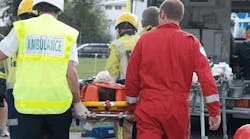There is a tendency to see disasters as a class by themselves, one that requires specialized plans and procedures. The truth is that disasters are part of a continuum that begins with day-to-day problems. The processes we use to resolve these problems can be expanded and adapted for use in disasters.
Understand Your Risk
The first step in preparedness planning is to understand the risks that your organization faces.
We usually think about risk as a specific event such as an earthquake or a flood and focus our attention on the frequency and magnitude of the event. You really can’t do much about these two factors. The secret to successful preparedness planning is to understand that it is your vulnerability to the event that is important and you can do something about this. Note that we are considering impacts, not the cause, of the emergency.
Risk is relative. What is a crisis for one organization can be a routine occurrence for another. The difference lies in the vulnerability of the organization to the event.
We can change this vulnerability through mitigation. Mitigation reduces the potential impact of the event by reducing or eliminating the harm caused by those impacts. For example, seismically retrofitting a plant in an earthquake zone increases the chance of it surviving an earthquake and thus reduces your vulnerability to earthquakes.
Know Your Organization
Once you understand the potential impacts facing your company, you can consider what these impacts would do to your business. If you are forced to close for a period of time, what will it cost you in lost business, lost discounts, late payment fees or contractual penalties?
In business continuity, we refer to this as a business impact analysis and we use the results to perform a cost-benefit analysis on proposed preparedness costs. But it’s not rocket science; as a good business person, you should know what it costs you to be out of business for a day.
There are other potential impacts that aren’t quite as quantifiable. Would a disaster result in a decreased demand for your services because your clients are affected or will it result in an increase in business because new clients need your services either permanently or short term? How likely are your clients to remain in business after a disaster? This is the type of market forecasting we do every day – we’re just looking at it in the context of a disaster.
Knowing your organization extends to knowing how your staff will perform in a crisis. You already know which of your employees are reliable in crisis. Like most managers, you probably have a “brain trust” of key employees on whose judgment and advice you rely for daily operations.
Consider these employees as the nucleus of your crisis management team. Remember that it’s not about job titles but about trust and expertise. By using the same team in varying levels of crisis, you train them and build a rapport that will pay dividends in a large crisis.
Think Systematically
It’s common to develop a disaster management plan that is distinct from all your daily plans and procedures with the expectation that this plan will only be used in a disaster. But disasters aren’t always big events and plans must be scalable. Instead of focusing solely on big events, think systematically.
How do you approach a routine emergency? Your first thought usually is, “Is everyone okay?” Your next thought is, “What do I need to do to fix this and get back to business?” You try to figure out what’s happened, you gather together the people who can fix the problem, and you get on with it.
While there are some differences, this is the same thing you do in a larger event. There are six basic steps you want to take:
- Take immediate life safety measures to protect your staff and limit damage. This might include evacuation, using fire extinguishers, etc.
- Assemble your crisis management team.
- Assess the damage. In a large event, this includes information about what is happening within your community. One of the problems with disasters as opposed to local emergencies is that the resources you rely on daily may also be affected.
- Develop an action plan. Identify those things that need to be done immediately. There are short-term issues that must be addressed at once but there also are long-term issues that may need to be decided upon and addressed as soon as possible.
- Plan for personnel support. Your employees will be anxious, some may be injured, and some may not be able to get home. You’ll need to make provisions for taking care of them.
- Implement a crisis communications plan. At minimum, you’ll want to communicate with your employees, but remember that your customers also will be concerned. Keeping them in the loop may be the key to keeping their business.
However you approach preparedness planning, remember that to be effective, your plans must be an outgrowth of how you do business. You can’t just switch off your daily routine in a crisis. Instead, the trust and relationships that you’ve built and the procedures you have in place before the crisis will ultimately determine whether your organization stays in business.
About the author: Lucien G. Canton, CEM, is a consultant specializing in preparing managers to lead better in crisis by understanding the human factors often overlooked in crisis planning. A popular speaker and lecturer, he is the author of the best-selling Emergency Management: Concepts and Strategies for Effective Programs. For more information, please visit www.luciencanton.com, or email [email protected].
